Tickets can be purchased either by cash or credit card depending on the distance.
Tickets for short distance trips are best purchased at vending machines, while tickets and seat reservations for long distance trips can be purchased at ticket counters by credit card in train stations.
We hope the list below helps you quickly find the train you want to catch.
Transportation
Getting down town from Airports
Narita Airport
to Tokyo Station (37min.)
- Narita Airport
(Terminal 1) - Keisei Skyliner
- Nippori Station
- JR Keihin-Tohoku
Line, Local train - Tokyo Station
to Yokohama Station (84min.(Nonstop))
- Narita Airport
(Terminal 2) - Narita Express
- Yokohama Station
to Shinjyuku Station (56min.)
- Narita Airport
(Terminal 2) - Keisei Skyliner
- Nippori Station
- JR Yamanote Line
- Shinjyuku Station
to Keiseiueno Station (41min.)
- Narita Airport
(Terminal 2) - Keisei Skyliner
- Keiseiueno Station
http://www.narita-airport.jp/en/access/index.html (Narita Airport Official website)
Haneda Airport
to Tokyo Station (37min.)
- Haneda Airport Station
(Haneda Airport Terminal 1) - Tokyo Monorail
- Hamamatsucho Station
- JR Keihin-Tohoku Line, Local train bound for Omiya
- Tokyo Station
to Tokyo Station (37min.)
- Haneda Airport Station
(Haneda Airport Domestic Terminal (Keikyu)) - Keikyu Airport Express
- Hamamatsucho Station
- JR Keihin-Tohoku Line, Local train bound for Omiya
- Tokyo Station
to Tokyo Station (43min.)
- Haneda Airport Station
(Haneda Airport Domestic Terminal (Keikyu)) - Keikyu Airport Express
- Tokyo Station
https://www.tokyo-airport-bldg.co.jp/en/ (Haneda Airport official website)
Nagoya Airport
to Meitetsunagoya Station (28min.)
- Central Japan International Airport Station
(railway station) - Bound for Meitetsugifu
- Meitetsunagoya Station
to Toyohashi Station (90min.)
- Central Japan International Airport Station
(railway station) - Meitetsu Express
- Kanayama Station
- JR Tokaido Main Line New Rapid bound for Toyohashi
- Toyohashi Station
to Hamamatsu Station (120min.)
- Central Japan International Airport Station
(railway station) - Meitetsu Express
- Meitetsunagoya Station
- (Walk to the station)
- Nagoya Station
- JR Tokaido Sanyo Shinkansen
- Hamamatsu Station
http://www.centrair.jp/en/to_and_from/ (Central Japan International Airport official website)
Kansai International Airport
to Shinosaka Station (50min.)
- Kansai Airport
(train station) - JR Limited Express Haruka
- Shinosaka Station
to JR Nanba Station (34min.)
- Kansai Airport
(train station) - Nankai Express
- JR Nanba Station
to Kyoto Station (75min.)
- Kansai Airport
(train station) - JR Limited Express Haruka
- Kyoto Station
http://www.kansai-airport.or.jp/en/index.asp (Kansai International Airport official website)
Osaka International Airport(Itami Airport)
to Umeda Station (29min.)
- Osaka Airport Station
- Osaka Monorail
- Hotarugaike Station
- Hankyu Takarazuka Main Line
- Umeda Station
to Kyoto Station (71min.)
- Osaka Airport Station
- Osaka Monorail
- Hotarugaike Station
- (Walk to the station)
- Osaka Station
- JR Tokaido Sanyo Line
- Kyoto Station
to Kobe Sannomiya (Hanshin) station (57min.)
- Osaka Airport Station
- Osaka Monorail
- Hotarugaike Station
- Hankyu Takarazuka Main Line
- Juso Station
- Hankyu Kobe Main Line
- Kobe Sannomiya (Hanshin) station
http://osaka-airport.co.jp/en/access/ (Osaka International Airport (Itami Airport) official website)
New Chitose Airport
to Sapporo Station (40min.)
- New Chitose Airport Station
- JR Rapid Airport
- Sapporo Station
to Hakodate Station (180min.)
- New Chitose Airport Station
- JR Rapid Airport
- Minamichitose Station
- Hokuto
- Hakodate Station
to Asahikawa Station (120min.)
- New Chitose Airport Station
- JR Rapid Airport
- Minamichitose Station
- Hankyu Takarazuka Main Line
- Asahikawa Station
http://www.new-chitose-airport.jp/en/access/ (New Chitose Airport Terminal Official website)
Fukuoka Airport
to Dazaifu Station (49min.)
- Fukuoka Airport Station
- Fukuoka City Subway Airport Line
- Tenjin Station
- (Walk to the station)
- Nishitetsu fukuoka Station
- Nishitetsu Tenjin Omuta Line
- Nishitetsu futsukaichi Station
- Nishitetsu Dazaifu Line
- Dazaifu Station
to Kokura Station (39min.)
- Fukuoka Airport Station
- Fukuoka City Subway Airport Line
- Hakata Station
- JR Tokaido Line Sanyo Shinkansen
- Kokura Station
to Hakata Station (6min.)
- Fukuoka Airport Station
- Fukuoka City Subway Airport Line
- Hakata Station
http://www.fuk-ab.co.jp/english/access.html (Fukuoka Airport Official website)
Trains
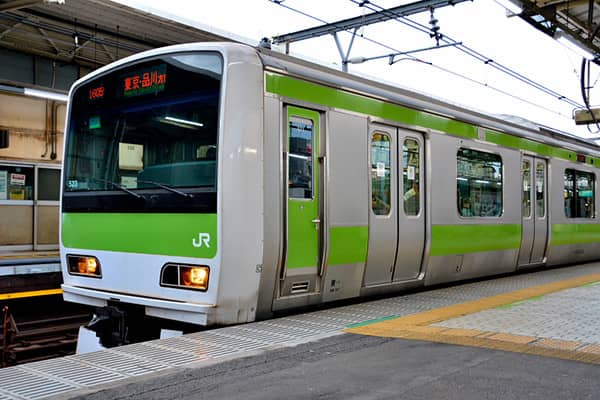
Mass transit in the Greater Tokyo Area
-
Railway JR East
Tokaido LineJR East
Yokosuka LineJR East
Chuo LineJR East
Keihin Tohoku LineLine color /signal Railway JR East
Keihin Tohoku LineJR East
Joban LineJR East
Sobu LineTobu
Isesaki LineTobu
Tojo LineLine color /signal Railway Tobu
Isesaki LineTobu
Tojo LineSeibu
Ikebukuro LineSeibu
Shinjuku LineKeisei
Main LineKeio Line Line color /signal Railway Seibu
Shinjuku LineKeisei
Main LineKeio Line Keio
Inokashira LineOdakyu
Odawara LineTokyu
Toyoko LineTokyu
Den en toshi LineLine color /signal Railway Keio
Inokashira LineOdakyu
Odawara LineTokyu
Toyoko LineKeikyu
Main LineLine color /signal Railway Tokyu
Den en toshi LineKeikyu
Main LineLine color /signal
Subway Mass transit in the Greater Tokyo Area
-
Railway Tokyo Metro
Ginza LineTokyo Metro
Marunouchi LineTokyo Metro
Tozai LineTokyo Metro
Yurakucho LineLine color /signal Railway Tokyo Metro
Yurakucho LineTokyo Metro
Chiyoda LineTokyo Metro
Hanzomon LineTokyo Metro
Fukutoshin LineTokyo Metro
Namboku LineLine color /signal Railway Tokyo Metro
Fukutoshin LineTokyo Metro
Namboku LineTokyo Metro
Hibiya LineToei
Asakusa LineToei
Mita LineToei
Shinjuku LineLine color /signal Railway Toei
Asakusa LineToei
Mita LineToei
Shinjuku LineToei
Oedo LineLine color /signal Railway Toei
Oedo LineLine color /signal 
Mass Transit in Keihanshin (Greater Osaka-Kyoto-Kobe)
-
Railway Kintetsu
Nara LineKintetsu
Osaka LineKintetsu
Minami Osaka LineKintetsu
Kyoto LineLine color /signal Railway Kintetsu
Kyoto LineNankai
Koya LineNankai
Main LineKeihan
Main LineHankyu
Takarazuka LineLine color /signal Railway Keihan
Main LineHankyu
Takarazuka LineHankyu
Kobe Main LineHankyu
Kyoto Main LineJR West
Osaka Loop LineJR West
Katamachi LineLine color /signal Railway Hankyu
Kyoto Main LineJR West
Osaka Loop LineJR West
Katamachi LineJR West
Hanwa LineLine color /signal Railway JR West
Hanwa LineLine color /signal 
Subway Mass transit in the Greater Osaka-Kyoto-Kobe
-
Railway Midosuji Line Tanimachi Line Yotsubashi Line Sakaisuji Line Line color /signal Railway Sakaisuji Line Seishin Yamate Line Kaigan Line Karasuma Line Tozai Line (Kyoto) Line color /signal Railway Karasuma Line Tozai Line (Kyoto) Line color /signal
Please note that you might find women-only cars especially during rush hour (7:30am-9:30am)
But in general, the policy is effective only on weekdays, excluding holidays.
"Woman Only" sign inside Tokyo Metro carriage

"Woman Only" sign inside Tokyo Metro carriage
Buses
Using buses in Japan can be a little challenging to overseas tourists because there are usually few English displays and you hear only Japanese announcements, and there are different systems of ticketing depending on the company.
The easiest area to get in bus would be in central Kyoto as a flat fare applies. This means you always pay the same price regardless of how far you travel.
Or even better, if you are traveling in Kyoto for a couple of days, you could use Kyoto 1 day (2day) pass. It offers unlimited travel for 1 or 2 consecutive days on all municipal buses, the subway and most Kyoto bus routes, and also special privileges offered with the Kyoto sightseeing guide Map are included.
About Kyoto 1day(2day) pass
http://www.arukumachikyoto.jp/static.php?page=otoku_ticket&lang=en
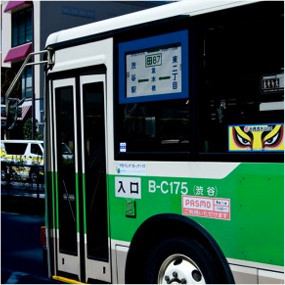
Buses
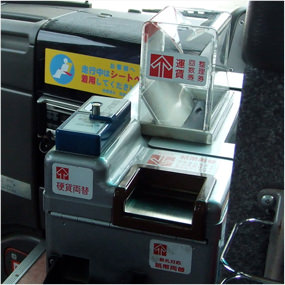
Fare box
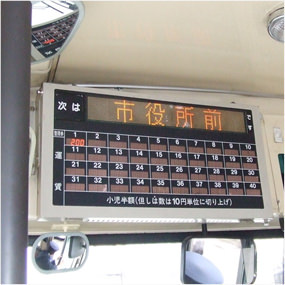
Fare table display
Driving in Japan / Car Rental
Cars
-
Visitors from overseas can drive in Japan with an International Driving Permit (IDP) for a maximum of one year.
Cars drive on the left side of the road and have the driver’s seat and steering wheel on their right side.
It is not allowed to park on most streets.
Please drive carefully as Japan has many one way streets.
Here are the examples of important Japanese traffic signs.
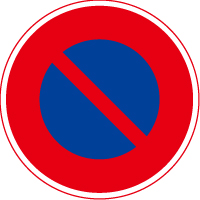
No Parking
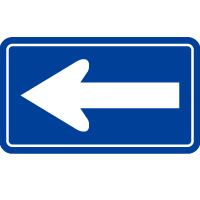
One-Way
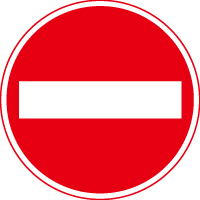
Close to All Vehicles
Car Rental
-
The minimum age for driving in Japan is 18 years, and you will need a Japanese driver's license or an International Driving Permit (IDP) and a passport in order to rent and drive a car.
- Most Japanese car rental companies accept credit cards.
Rental cars are supposed to be returned with a full tank of gasoline.
The types of gasolines are “regular”, “high-octane gasoline” and “light diesel oil”; please check it when you rent a car.
There are two kinds of stations you can fill up your car.
- 1. Full service station: when you pull into the station, an attendant may direct you to a stall. Park, open your window and shut off your car. Tell the attendant what kind of gas (e.g. "regular"), how much (e.g. "mantan" for full tank) and how you will pay (e.g. "credit card"). He may give you a wet towel to clean your dash or ask to take your garbage. When finished he may ask which direction you wish to leave and then direct you out into traffic.
- 2. Self service station: it only provides apanese language menus. If in trouble, an attendant should be present and able to help you.
- Most Japanese car rental companies accept credit cards.
The use of most expressways is subject to tolls, which can be paid at manual toll gates by cash or credit card or by passing through automatic ETC (electronic toll collection) gates.
Please choose to pass through the green sign which says “一般” (regular) as your rented car is not with ETC card.
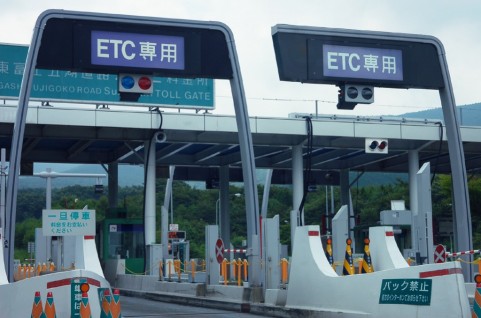
“ETC only” gate
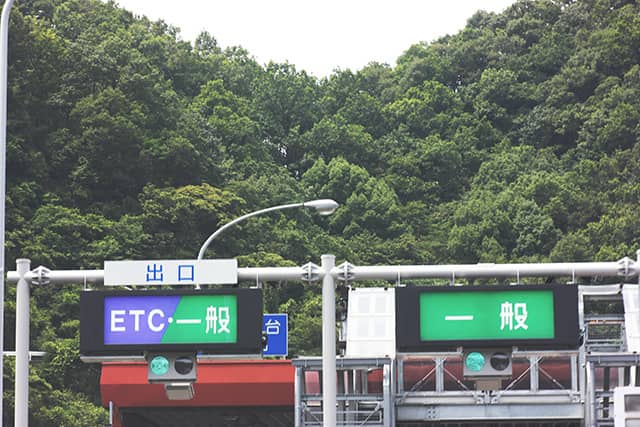
ETC and Regular gate (on the left)・Regular gate (on the right)
Taxies
When you board a taxi, note that the vehicle's left rear door is opened and closed remotely by the driver. By law, you must wear a seat belt.
If you do not speak Japanese or if your destination is not a well known place, it is recommended to give your driver the address of your destination on a piece of paper or point it out on a map. (You could also show “Cozy Japan” website information to the driver)
Taxi fare is shown on the meter next to the driver seat. The price is not negotiable with the driver. Eventual expressway toll fees incurred during the trip are added to the fare. Great thing is you do not have to tip taxi drivers.
You can pay by either cash or a credit card (you can find the information of acceptable credit cards on the window of the car)
English speaking operator dial for calling a taxi:03-5755-2336 ( 24-hour assistance is available)
Bicycle
Basically, cyclists are supposed to use the streets and not the sidewalks, except when signs indicate that the sidewalks are for use by both pedestrians and cyclists.
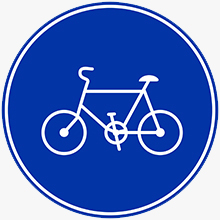
“Bicycle only” sign
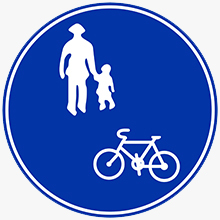
“Bicycle and pedestrian only” sign
Rental bicycles are available in many tourist destinations. Some shops require photo identification, such as passport, for rentals. Many shops accept credit cards but it is always safe to have some cash with you.
Please park your bicycle at parking areas near railway stations and shopping centers, etc.
“Bicycle parking” sign (example)
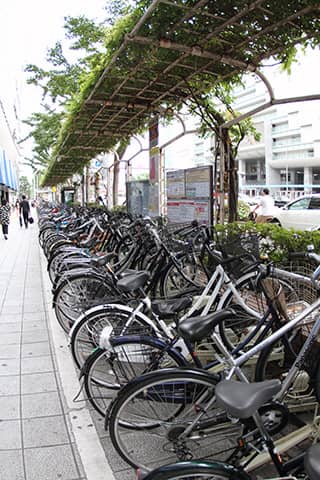
“Bicycle parking” sign (example)

